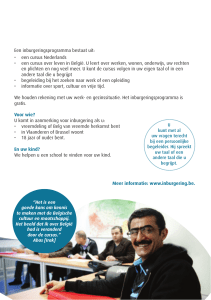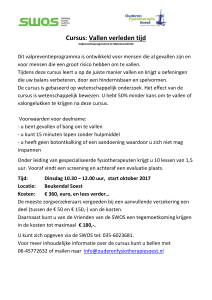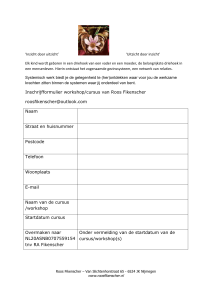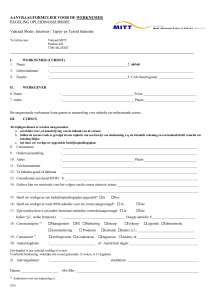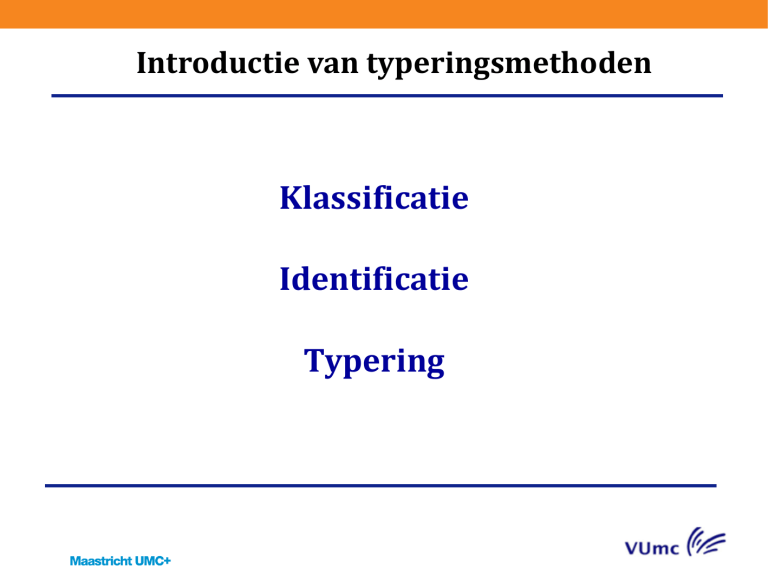
Introductie van typeringsmethoden
Klassificatie
Identificatie
Typering
cursus Breda 2008
1
3 Domeinen
cursus Breda 2008
2
Taxonomie
Domein, Familie, Genus, Species, Subspecies, Stam
Klassificatie
identificatie
typering
Voorbeeld:
Domein: Bacteriën
Familie/Phylum: Firmicuta (gram positieven)
Genus: Staphylococcus
Species: aureus
Stam: toevoeging aan naam (Staphylococcus aureus mu50)
cursus Breda 2008
3
Bij identificatie en typering worden mbv
verschillende laboratorium technieken
verschillen en overeenkomsten
tussen micro organismen bepaald
cursus Breda 2008
4
Moleculaire typering van microorganismen
•
Detecteren van identieke stammen
•
Determinatie van micro-organismen
•
Detecteren van antibioticum resistentie genen
en/of virulentie factoren
•
Detecteren van overdracht van mobiele
elementen
cursus Breda 2008
5
Strain characteristics
Mutations
Recombinations
Vertical transfer of genes
Horizontal transfer of genes
Some general definitions
Mutation
A heritable change in the sequence of nucleotides
in DNA
Mutation rate
Bacteria: 1 in 106-107 to 1010-1011
Types of mutations
Point mutations (transitions/transversions)
Insertions
(tandem)duplication
Inversion
Deletions
Effect of mutations
What’s the risk for typing?
Effect mutatie frequentie is species afhankelijk
Intrinsieke variatie in species: Enterococcen,
Salmonella, Neisseria
Dit leidt tot een biologische variatie binnen
dezelfde stam
Diepte van typeringsmethode:
hoe nauwkeuriger hoe meer verschillen
Aanpassing typeringstechniek door focus op
stabiele genen (bijv. MLST)
De bacteriële cel
cursus Breda 2008
11
componenten
cursus Breda 2008
12
Typeringsmethoden
Fenotypisch
Biotypering
Antibiogram typering Serotypering
Faag typering
Bacteriocine typering
Eiwit profilering
Multilocus isoenzyme electrophorese (MLEE)
Biochemische Karakterisatie
(Massa/Raman-)Spectrometrie
Genotypisch
Non-amplificatie gebaseerd
Amplificatie gebaseerd
cursus Breda 2008
13
Eiwit analyse
Seifert et al.
Cell envelope protein profiles of 20 Acinetobacter isolates
cursus Breda 2008
14
Genotypisch
typeren
Fenotypisch
typeren
cursus Breda 2008
15
Genotypische methoden
Non-amplificatie gebaseerd:
DNA-DNA reassociatie
DNA sequencing
Restrictie Fragment Lengte Polymorfisme (RFLP)
Pulse Field Gel Electroforese (PFGE)
Optical Mapping
cursus Breda 2008
16
Genotypische methoden
Amplificatie gebaseerd
16S rDNA sequencing (identificatie)
Multi Locus Sequence Typering (MLST)
PCR-Restriction Fragment Length Polymorphism (PCR-RFLP)
Amplified Ribosomal DNA Restriction Analysis (ARDRA)
Random Amplified Polymorphic DNA (RAPD)
Arbitrarily Primed PCR (APPCR)
Amplified Fragment Length Polymorphism (AFLP)
Inter tRNA Sequence-PCR (ITS-PCR, tRNA)
Inter 16S-23S rRNA-sequences
rep-PCR, MLVA, SNP
etc. etc. etc...........NGS....
cursus Breda 2008
17
Pulse Field Gel Electrophoresis (PFGE)
Proteinase K
Restriction enzymes
Agarose embedded bacteria with enzymes
PFGE profile
Fragment separation
Embedded
digested
bacteria placed in
agarose gel wells
Electric Pulse Field separation
cursus Breda 2008
18
Restriction Fragment Length Polymorphism (RFLP)
Chromosomal DNA
Digestion with restriction enzymes
several enzymes
several probes
Fragment separation
Probe hybridisation
Southern blot
Agarose gel
Nitrocellulose paper
Restriction analysis
Most non-amplification based techniques rely on DNA
digestion with restriction enzymes
Enzymes recognize (palindromic) stretch of nucleotides:
TAAT: MseI
GAATTC : EcoRI
GGGCCC: ApaI
decreasing
frequency
of digestion
increasing
number
of fragments
In general:
Restriction fragment analysis has a high discriminatory power
RAPD
Random amplified polymorphic DNA
CARRIED OUT WITH
ONLY ONE PRIMER
Amplification at low
annealings
temperature
with one primer
RAPD profile
Agarose gel separation
Quick & Dirty
cursus Breda 2008
21
PCR-RFLP/ARDRA/ITS-PCR
Specific amplification of
one or more genes
ARDRA profile
PCR fragment
Digestion of PCR fragment
with restriction enzyme(s)
Fragment separation in
(agarose) gelmatrix
rep-PCR
Geconserveerde repetitieve
elementen
BOX, ERIC, REP
verspreid aanwezig bij
de meeste bacteriën
Stringente vermenigvuldiging van
specifieke chromosomale regios
rep-PCR
profile
(agarose) Gelelectrophorese
cursus Breda
2008
Geautomatiseerd systeem:
Diversilab
23
Example of a complete rep-PCR analysis
20
40
60
80
100
BOX
ERIC
REP
?
14
14
14
14
9
9
2
2
13
13
13
13
5
5
5
5
5
5
1
1
1
1
19
19
19
19
4
4
4
4
11
11
11
11
11
11
10
10
10
10
10
10
15
15
15
15
15
15
15
15
15
15
20
20
20
20
17
17
17
17
Amplified Fragment Length Polymorphism (AFLP)
CHROMOSOMAAL DNA
SIMULTANE knip en plak
(restrictie & ligatie)
AATTC
G
G
CTTAA
AATTC
G
T
AAT
CTCGTAGACTGCGTACCAATTC
CATCTGACGCATGGTTAAG
T
AAT
TAA
T
TTACTCAGGACTCAT
AATGAGTCCTGAGTAGCAG
STRINGENTE
AMPLIFICATIE
TTACTCAGGACTCAT
AATGAGTCCTGAGTAG
CTCGTAGACTGCGTACCAATTC
GACTGCGTACCAATTC
CATCTGACGCATGGTTAAG
AATGAGTCCTGAGTAGCAG
PAGE
cursus Breda 2008
25
Amplified Fragment Length Polymorphism (AFLP)
In fact a combination of RFLP & rep-PCR:
restriction analysis combined with specific amplification
Presently there are several variations on the method
Two main variations:
High frequent-medium frequent DNA digestion on PAGE
Medium frequent DNA digestion on agarose
Selection of fragments analyzed on PAGE
All fragments analyzed on Agarose
Vos, et.al. NAR 1995
40 50 60 70 80 90
100
500bp
400bp
300bp
200bp
100bp 50bp
S. capitis
S. capitis
S. capitis
S. capitis
S. capitis
S. capitis
S. capitis
S. capitis
S. cap(ref
S. cap(ref
S. aureus
S.aureus
S. aureus
S. warneri
S. warneri
S. epiderm
S. epidermidis
S. epiderm
S. epiderm
S. haemolyticus
S. haemo
Example AFLP result
Agarose AFLP
Chromosomal DNA
Digestion & ligation
One or more enzymes can be used
Each enzyme with specific adaptor
Fragments can be isolated from gel
No expensive platform needed
All fragments are amplified
Specific PCR amplification
Fragment separation
DNA sequencing MLST
(Multi locus sequence typing)
Specifieke vermenigvuldiging
van delen van meerdere genen
Primer labeling of
ddNTP labeling
primer
PCR reactie 1
3’
A C T G C T A C G T T
5’
dNTP dNTP dNTP dNTP
+
+
+
+
ddATP ddTTP ddCTP ddGTP
PCR reactie 2
Verschillende huishoudgenen als evolutionaire klok
Neisseria meningitidis: abcZ, adk, aroE, gdh, mtg, pdhC,
pgm, pilA, pip, ppk, serC
cursus Breda 2008
A
A
C
G
T
A
G
C
A
G
T
3’
TGACGATGCAA
TGACGATGCA
TGACGATGC
TGACGATG
TGACGAT
TGACGA
TGACG
TGAC
TGA
TG
5’
T
29
S. aureus specifieke typering: Proteïne A (Spa)
cursus Breda 2008
30
MLVA
Specifieke vermenigvuldiging van een
of meerdere repeterende stukjes DNA
Aantal repeats: 1,2,3,etc aantoonbaar
Het aantal repeats bepaalt de uitslag
PCR reactie 1
4
PCR reactie 2
2
Bijvoorbeeld: 1 2 5 7 2 4 6 8
1
Lengte van PCR product hangt af van aantal repeats en is stam specifiek
cursus Breda 2008
31
Genus Species Subspec. Strain
DNA-DNA reassociation
Speed Ease Platf. Typ. Flex. €
>>24h
16S rDNA sequencing
24h
RAPD
8h
PFGE
-
n.a.
n.a./I
H
+
S
D/I
H
+++
A
C/T
H
48h
++
A
D/IT
H
Diversilab (rep-PCR)
24h
+++
A
D/T
SS
AFLP
24h
+++
A/S
DC/IT
H
MLST
48h
++
S
D/IT
SS
MLVA
24h
+++
A/S
D/T
SS
Raman Spectrometry
48h
+++
n.a.
D/IT
SS
Optical mapping
48h
+
n.a.
D/IT
H
SNP analyse
24h
+
S
DT
SS
Pathotypering
Aantonen specifieke genen
(bijv. resistentie of virulentie)
Aantonen overdracht mechanisme
(bijv. integronen,plasmiden)
Aantonen puntmutatie
(bijv. ESBL genen)
cursus Breda 2008
33
Specifieke genen:
toxinen, resistentie, epidemiologische markers
Mobiele fragmenten:
Transposons, Integronen, Plasmiden, insertie elementen
Technieken:
MLPA (checkpoints), sequencing, SNP, smeltcurve, Microarray
Ook integratie in andere methoden: mecA in MLVA
Smeltcurve analyse PCR resultaat
INcI1
FIB
Diverse plasmiden: IncI1, Col E, FIB, FIC, etc. =22
SNP
Single Nucleotide Polymorphism(s)
Mostly used in human genetics for:
- Allelic discrimination (homo/heterozyg.)
- Point mutation detection (BRCA1/2)
Microbiological SNP applications
-Microbiology: Antibiotic resistance (point mutations)
ESBL genes e.g. (not checkpoint system)
-Strain typing (stable SNPs)
Advantages: - applicable on clinical samples
- useful for non-cultivable strains
E.g. Coxiella burnetii
SNP 2011
38
SNP analyse
Twee amplificatie primers met twee probes
Elke probe gelabeld met verschillend fluorofoor
Punt mutatie in het midden van de probe
Eindpunt meting
Signaal verhouding bepaald conclusie
SNP 2011
40
SNP 2011
42
SNP techniques
Real Time PCR (probe differences)
Pyrosequencing
SNaPshot analysis
Mass spectrometry (MALDI-TOF)
Rolling circle
DNA Micro-array
MLPA (checkpoints)
Enkele toevoegingen
-Spoligotyping: Discrimination between
M.tuberculosis strains
-Riboprinter: Combination of ARDRA & ITS-PCR
- rep-PCR vs REP-PCR
SMT 2013
45
Terminologie
Typeerbaarheid (Typeability):
de bruikbaarbaarheid van een methode om tot een type aanduiding
te leiden (= % typeerbare stammen)
Onderscheidend vermogen (Discriminatory power): de resolutie van
de methoden om onafhankelijke stammen te onderscheiden
Overeenkomst met andere typeermethoden (Concordance): de mate
van overeenkomst met epidemiologische waarnemingen
Reproduceerbaarheid (Reproducibility): reproduceerbaarheid
van de methode onafhankelijk van de tijd.
Toepasbaarheid (Flexibility): het aantal verschillende species
dat met de methode getypeerd kan worden
SMT 2013
46
Wanneer gebruik je nu welke methode?
-Afhankelijk van vraagstelling
-Waar ligt de prioriteit: Snelheid? Nauwkeurigheid?
-Flexibiliteit?
- Typeerbaarheid?
Niveau van identificatie/typering
Mondiaal
Continentaal (Europees)
Nationaal
Regionaal
Lokaal (Ziekenhuis)
Juiste techniek hangt af van niveau
cursus Breda 2008
47
Palleroni (1983):
“In spite of all the progress, the concept of
bacterial species still remains as elusive as
ever”


